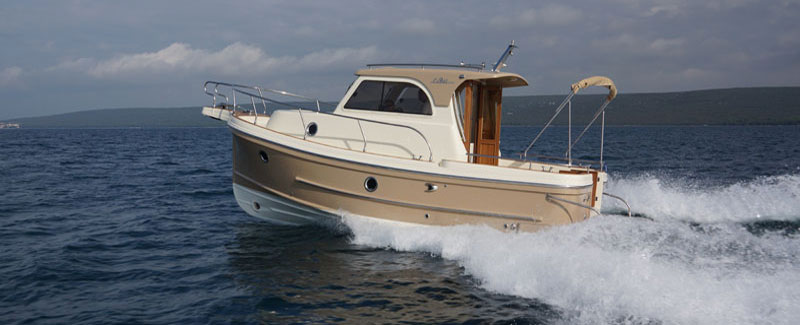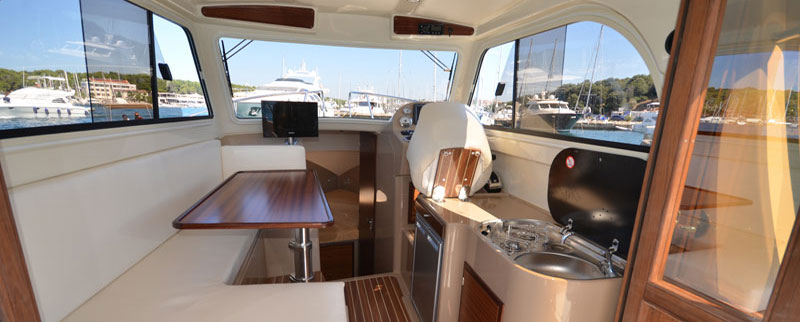Irresistibly Charming Boat More // Vedran Bozic // 24.07.2009
The three-year work invested in the development of this vessel has more than paid off: the interest of visitors of Zagreb Fair announced that the affordable price and multifuncionality will guarantee to attract customers of different profiles.
If Croatia had more young people like Marsel Brkich, the domestic shipyards in economic instability during the times like these wouldn’t fear for the future. When he was only 27 years he founded his own business for repair and manufacture of fiberglass boats in 2005, after ten years of work at various shipyards.
His debut was a nice pasara named Leidi 490 in version of the cabin and without it (so far he built more than a hundred copies). Although very similar to some boats on the market, he managed to find a way to customers primarily due to a very high level of finish and special attention dedicated to details, and correct relations to the customers, and certainly because of the very low prices.
Shortly after the founding of his shipyard, which is found in the center of Pula, a logical flow led him to think of a larger vessel. It didn’t take long to decide how his next boat shouldn’t be larger than the first vessel and the length of the border troops was defined around six feet. It had to be multifunctional and semiplasmanic, but questioning of what kind of engine to install gave him problems. This was the start of project Leidi 600, and after a careful thought he decided for a outboard motor. He spent three years and his own resources in it’s development.

In the market filled with local boats with similar length he was not in a hurry because he wanted to present a finished product, developed and perfected to the last detail. Genuine semi-displacement hull, built almost by definition in the book, was repeatedly tested in the sea before the finished product. After much effort and time Leidi was finally ready for presentation at the Zagreb nautical Fair.
Classic-modern lady
Leidi looks bigger than it actually is. Retrodesign except curved baseline deck that highlights black fence, is most evident with vertical bow, straighter and regular sides of the cabin, especially with the two round inox windows on each side. All this makes the appearance of the boat even more charming, and I doubt that someone will not like it.

I came across the bow on a very nice and solid steinless steel bridge, which has a middle deposit for the anchor, and left and right tread surface is made of teak. The bridge can be made of fiberglass.The anchor is Bruce type, made of stainless steel weighting 7.5 kg, and with 50 meters of chain and electric winch power of 600 W makes every anchorage simple and secure. Inox type fence has a diameter of 30 mm and monitors the side passages all the way to the cockpit. The stem has a two well-placed inox cleats and foot control winches, and right behind it there is a cover for anchor chain.
All this is on the forepeak, slightly raised with respect to the main tread, which is made huskily that even wet would be slippery. On the lower horizontal surface of the cabin there is no hatchway so you can sit comfortably, and shorter people can even sunbathe. Side passes are more than wide enough, about six centimeters.
On the flat roof of the upper cabin, ie the wheelhouse, there is one handrail on each side, at the end of a nice inox roll-bar, which serves as a carrier for navigation lights, and on the test vessel as a carrier of electric lights and sirens. On it will fit a GPS antenna, and friendly Marsel will certainly adjust it for a box of radar antennas.
Five star cockpit
To enter the rather large cockpit you need to step over a small barrier that prevents water entering into it and through small steps and a vertical grip on the aft side of the upper cabin almost to the sea level. Cockpit floor is clean and flat, and two drain holes self empty it. By the middle we find a large part of the cover that hides inox fuel tank capacity of 180 liters and one little plastic of 12 liters for heating built by the owner's request. Left and right have two smaller gavons that still fit in a lot of equipment. The stern has two benches, which are also deep repository, separated by several inches wide partitions dividing them from the Suzuki engine with 140 horses

Through them you need to step over in order to access the two stern platforms in combination of stainless steel and teak, one of which contains a handy slide of auxiliary engine, while the left is empty and under it are drawn ladder for swimmers. The platforms will be a standard feature of glass-plastic. Closed reservoir fresh water showers is next to the engine compartment by the left bench. The future copies will have along the side wall of the cockpit folding teak benches.
A detailed inspection of the deck ended up at the glass cabin door and white painted aluminum, which, surprisingly, did not slide like on the other boats with a similar concept, but are composed of two equal parts which open separately on the side. That is perhaps better because they could be placed in the middle and still have enough room for a kitchen corner on the right and a small sofa to the left of the cabin. They are high about 140 centimeters, and the person needs to stoop to enter, and at the same time exceed over the lower wall, which prevents water from entering the cockpit, then go through a scale down in the cabin. This scale lifting of the upper surface is also the repository for a service and a battery for ignition.
Practical and simple
The entire interior, the wooden parts are made from mahogany while the flooring is an teak imitation. The side windows were plain and can be opened almost by half for better ventilation. Kitchen block has a dual function, except meal preparation the soft coated skipper's chair leans on it. Its lifting and folding glass lid reveals a sink and gas stove. The same block contains a small refrigerator and a cabinet. Not much, but it is very practical and usable. On the opposite side there are two small benches with a nice table, whose descent usually gets an extra bed. Beneath the bench are the repositories, and the one closer to the bow has no restraint, but the bow couch continues to her and on its opening has a heating shaft. It is lined with soft yellow pillows, and surprisingly spacious and can comfortably accommodate two adults diagonally. Below him is a great storage which occupies a flexible bag water tank in capacity of 100 liters. There is also a toilet compartment with sea toilet and the right window for ventilation, and easily accessible water supply and drainage valves.
The control console is very simple and clutter free, it contains all the necessary engine instruments, compass, windlass button and siren, control panel, heating, CD radio device, an outlet to 12 V, two panels with fuses and a five shank wheel with a Garmin GPS plotter. Along the right side there is a command throttle for the motor, remote control spotlights and underneath them are the main electrical switches and an open storage. Sitting in his position, the helmsman can rest his feet on an intended inox tube while the view still remains excellent.
Excellent hull, solid throttle, minimum consumption
When turned the engine i heard a quiet noise in the cabin which stopped as soon as Suzuki started, and operation at idle was no longer heard or felt. Marsel untied the knots and we went towards the islands of Veruda and Frašker looking for a place for a foto session. We found him on a fishing pier in the bay of Banjole, while in the meantime, I sat at the wheel and tried to see how it behaves on sea.
However, the sovereign behavior on smaller waves could conclude that the hull was excellently projected and balanced. It acts very firm and solid, so I don’t have any doubts that it won’t behave perfectly on higher waves. Specifically, it is designed that the bow is rather tapered and shaped like a deep V which can easily cut through the waves, while shifting to the stern in almost a flat surface to allow easier cruising and more stability. Good features give the boat a displacement of up to two tons so Marsel decided to make the block easier for some 300 kilograms so the performance could be even better. All that refers to easier kontraštampu, less ballast in the keel and a small amount of inox equipment, which the owner required in the first instance. 140 horsepower Suzuki works beautifully in all modes, and drives Leidi 600 solid. At a minimum gas the engine is spinning at 700 rpm while Leidi glides at 2.3 knots, which is ideal for maneuvers in harbors. Adding gas velocity increases linearly and at 2500 rpm it catches 7 knots, and at 3500 a full of 10.
However, between 4000 and 4500 revs Leidi mostly gains on speed, about 4.5 knots, so it can be concluded that then it switches to cruising. We realized the maximum speed of 20.5 knots at 5200 rpm and the engine was a bit loud, but for travel regime i would recommend to 5000 rpm and about 19 knots. In this mode the boat consumes about 20 liters of fuel per hour.
For fun, cruising or fishing
We could be easily entertained all afternoon, but we had to settle the impressions. That was not hard because after all seen, tried and tested i think that Leidi expects a bright future, as confirmed by the full hall of Marsel’s shipyard. Such willingness, commitment and vision to the organization is not often, and that his innovative project suceeded, witnesses the delight visitors of the Zagreb Fair have. He admits that some details must be improved or changed, but that shouldn’t be aproblem for him. Marsel is a very reasonable man, and the boat price ranges from HRK 136 000 including VAT for the basic model without the engine, while the fully equipped boat ready to cruise stands around 200,000 kuna. Each customer will determine it’s purpose, and I believe that she will manage the challenge, be it fishing, cruising or fun, without any problems.








